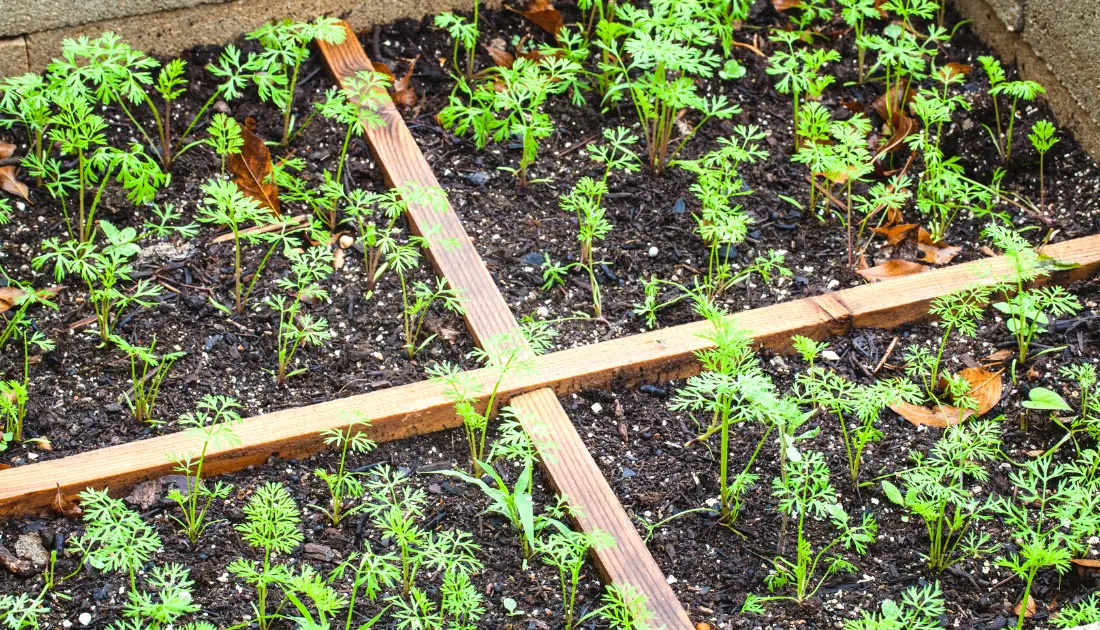The crunchy sound a carrot makes when eaten is one of my greatest reasons for planting a carrot. The other reasons include that carrots do not even need to be cooked before they are eaten because they can be eaten as a snack. But before eating a carrot comes the issues of planting and spacing.
Giving carrots the room they require to grow well is crucial. Otherwise, you will end up with small, malformed carrots despite your best efforts during the growing season.
How Far Apart Can a Carrot Be Spaced?

Carrots can have roots that extend up to 12 inches; therefore, the soil should be at least that deep. Initially spaced 1 inch apart, carrot seeds should be trimmed to 3 inches apart to provide each root room to develop. Thinning is an essential part of growing your vegetable.
When I grow broccoli, I thin them once they are a few inches tall.
Other carrot kinds are less than 12 inches long but are significantly larger. These carrots will require greater space between plants and less depth.
Carrots require a depth of up to 12 inches of smooth soil for healthy growth. The carrot root, which you eat, will reach a length of 2 to 12 inches.
A foot or more of soil is required because a carrot’s entire root develops underground. For taller types, loosen the soil to a depth of around 16 inches to give yourself leeway.
Since most carrots will be 0.5 to 1.5 inches when harvested, a carrot will require 3 inches of area to grow.
The greatest growth of carrots can be achieved on soft, sandy soil. It would help if you never planted carrots in soil that contains rocks, roots, hard dirt clumps, or other impediments that could cause carrots to grow malformed. To get rid of these particles from your soil, utilize a soil sifter.
Carrot Spacing in Raised Bed

Alternatively, you can plant your carrot on a raised bed. Your raised bed’s bottom should be at least 15 inches deep, and this offers room for adequate soil to support carrots with a maximum length of 12 inches. This gives you a 3-inch safety margin in case your carrots grow a little bit longer than intended due to exceptional growth( would you not like that?). Additionally, it provides a little opening for properly spacing the carrot seeds, which is only 0.25 inches.
The top should be 3 inches tall, with room for additional fabric later in the season. For instance, to help the soil retain moisture and act as insulation, you might work some fertilizer into the ground or spread a thin layer of mulch over it.
You might even construct your raised bed on top of a dirt mound if your taste calls for a higher raised bed.
You should be able to plant four rows of carrots in your raised bed for every foot (12 inches or 30 cm) of length (3 inches between plants). In a raised bed that is 4 feet long, you should be able to plant 16 carrots in a row.
Eight rows of carrots can be planted if your raised bed is 2 feet wide, and this would provide 128 carrots in a raised bed 4 feet long by 2 feet broad. Whether you are growing your carrot on a raised bed or container, the space specifications in this paragraph apply to both scenarios.
Caring For Your Carrots
There are different ways to care for your carrots to ensure that they grow and yield maximally. Even though carrots are hardy vegetables, they must be well taken care of.
- Water
Seeds must be maintained moist before germination by being watered daily and covered. The quantity and frequency of irrigation after sprouting rely on how quickly moisture evaporates, which is influenced by your soil type and the weather. I recommend using a moisture meter to ensure that carrots are adequately watered.
- Temperature
Carrots are temperature-sensitive. However, carrots can tolerate light frost. Some varieties reach their flavour apex in mild weather, while others reach theirs in warmer conditions.
Once the carrots have sprouted, cover them with mulch or compost to help regulate the temperature. Additionally, this will prevent the soil from becoming dry and crusty or from showing the root tips.
- Nutrients
Carrots prefer well-drained soil devoid of large boulders and rocks because these conditions will result in stunted or entwined carrots. Consider how much organic matter to add to your planting space and how deep you should plant your carrots. After tilling the soil, it is advisable to scatter a thin coating of wood ashes over the seedbed to give potassium to the soil and grow tastier carrots.
How to Thin Carrots

It’ll be time to thin out your carrots once they’ve had a chance to grow for a bit. Thinning will ensure that the healthy ones left will grow as big as possible. Before trimming the larger carrot seedlings, you should wait until they are 3–4 inches tall.
Pull up the smaller carrots to thin the crop to 3 inches apart. The spacing may be tight, but you can get away with 2 inches between carrots.
If you fail to apply correct thinning and maintain enough space between carrot plants, the competition from crowding may lead to smaller carrots. Ensure to water your carrots frequently to keep the soil moist as they grow. Keep in mind that the roots of a carrot can grow up to 12 inches deep!
In sandy soil, you’ll need to water more frequently. Additionally, when the weather is sunny and warmer, you will need to water more frequently because water evaporation will be faster.
